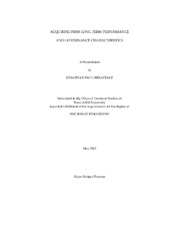| dc.description.abstract | I examine the market reaction to merger announcements and the long-term post-merger stock price performance of newly merged firms. For a sample of 484 acquiring firms completing mergers between 1993 and 2000, the average value-weighted abnormal announcement date return (market-adjusted) is a statistically significant -1.02%. On average, this reaction is more negative for firms with "good governance." Specifically, a governance index comprised of three governance variables is significantly negative in a multivariate regression of announcement date abnormal returns. Comp is the percentage of CEO salary consisting of equity incentives (including stock options and restricted stock grants), InsideOwn is the percentage of the firm owned by officers and directors, and InstOwn is the percentage of the firm owned by large outside block shareholders. Value-weighted calendar-time portfolios consisting of the full sample of acquirers exhibit significant abnormal returns of 9.12%, 33.84% and 55.8% for the 12, 36 and 60 months following the merger, respectively. This overperformance is limited to the value-weighted portfolios. There is calendar-time evidence of abnormal performance for some subsamples on a risk adjusted basis. However, when compared to a control group, abnormal performance is limited to large glamour acquirers on a 12-month horizon, large cash acquirers on a 36 and 60-month horizon, and small focusing acquirers on a 60-month horizon. Multivariate analysis of long-run returns reveals that use of equity and corporate diversification are associated with lower post-merger performance. With regard to governance and long-run stock returns, there is also evidence that suggests higher levels of incentive compensation for CEOs is associated with more successful merger transactions for long-term investors. | en |


